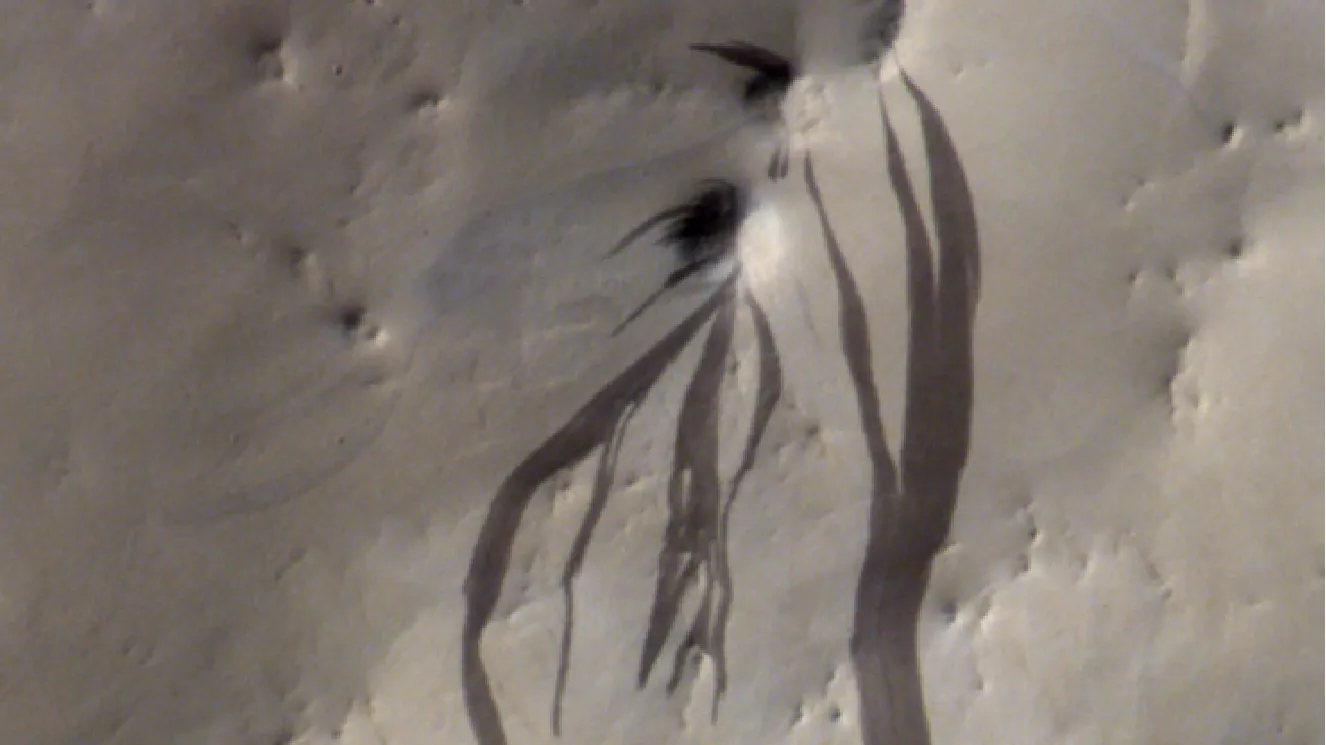First identified in the 1970s by NASA’s Viking mission, long, dark markings snake down Martian slopes, sometimes stretching across Mars’ surface for hundreds of feet.
Scientists have watched some of these markings exist for decades, while others, known as “recurring slope lineae,” appear to fade in a single season.
The geostatistical analysis revealed that slope streaks and recurring slope lineae don’t appear in places where you’d expect to find signs of liquid water or frost.
What precisely causes these slides can differ, the team explains, but slope streaks tend to show up more often near fresh impact craters.
Understanding how features like slope streaks and recurring slope lineae form is crucial in the quest to unlock the secrets of Mars and guide future Red Planet exploration efforts.
The long, dark markings, which occasionally extend hundreds of feet across the surface of Mars, were first discovered in the 1970s by NASA’s Viking mission. Certain of these markings, referred to as “recurring slope lineae,” seem to disappear in a single season, while others have been observed by scientists to persist for decades. They all, however, contrast sharply with the red, dusty surface of the planet.
The cause of these streaks has long been a contentious issue because modern Mars is dry and arid, with temperatures hardly ever rising above the freezing point of water. They were previously thought to be among the strongest indications that liquid water might still be present on Mars, indicating a unique area of habitability on an otherwise arid planet. The dominant hypothesis postulated that salty water was momentarily flowing across the frigid Martian surface due to seepage from subterranean sources, such as buried ice or subsurface aquifers. However, fresh data indicates that the phenomenon may be caused by something else.
“Understanding current processes on Mars — including the possibility of liquid water on the surface — is a big focus of Mars research,” said Adomas Valantinas, a postdoctoral researcher at Brown University, in a statement. “We examined these features in our study, but we couldn’t find any indications of water. Dry formation processes are preferred by our model. “..”.
After analyzing a large dataset of more than 86,000 high-resolution satellite photos of these streaks using machine learning, Valantinas and his colleagues have come to the conclusion that wind and dust, not flowing water, are more likely to be the cause.
In order to determine this, they mapped out more than 500,000 distinct features on the planet’s surface, producing the first global map of Martian slope streaks. According to Valentin Bickel, a researcher at the University of Bern, “Once we had this global map, we could compare it to databases and catalogs of other things like temperature, wind speed, hydration, rockslide activity, and other factors.”. Then, in order to gain a better understanding of the circumstances in which these features form, we could search for correlations across hundreds of thousands of cases. “,”.
The geostatistical analysis showed that recurrent slope lineae and slope streaks do not occur where one would anticipate finding evidence of frost or liquid water. For example, it would be anticipated that watery slopes would face a particular direction, endure sharp temperature fluctuations, or be found in an environment with high humidity. Rather, regions with higher dust activity and stronger winds are more likely to have these streaky features, according to the study.
This, according to the researchers, indicates that the streaks are created when fine dust particles slide down a steep hillside in thin layers. Slope streaks are more likely to appear close to recently formed impact craters, though the team notes that the exact causes of these slides can vary. An impact shock could shake dust loose there. Conversely, recurrent slope lineae are typically found in regions that experience frequent rockfalls or dust devils.
In order to discover the secrets of Mars and direct future Red Planet exploration efforts, it is essential to comprehend how features like slope streaks and recurring slope lineae form.
Scientists can rule out some options without sending expensive missions to the surface by examining these patterns from orbit using a big data approach. As a result, missions can concentrate more effectively on the most promising areas, advancing our understanding of whether life could have existed on Mars and ensuring that, as spacecraft travel farther and farther into space, we preserve the planet’s delicate ecosystems.
The study was released in the journal Nature Communications on May 19.







